AMD Kaveri Review: A8-7600 and A10-7850K Tested
by Ian Cutress & Rahul Garg on January 14, 2014 8:00 AM ESTDrawing Performance Conclusions
As I progressed through the testing for this review, I became aware of trends in two things: absolute performance, in terms of numbers, and generational improvements across platforms. With AMD moving the Bulldozer based architectures from Piledriver in Trinity and Richland to Steamroller in Kaveri, the base CPU design has had a relatively long run in order to be optimized to the limitations on the CPU side. Obviously AMD has also had a chance to change the lithography node in there as well, and as such has optimized for design rather than performance. This matters a great deal when we look at the power banding (45W, 65W, 95W) and performance in each segment.
In order to display just how much Kaveri has grown in relation to the previous generations, I processed our mountain of data to show graphs where percentage gain against the older generations really does matter. As mentioned previously in this review, it all depends on whether the software can take advantage of the new features afforded by the architecture. In this review we have spent a lot of time discussing advantages for Kaveri in terms of compute (HSA, hUMA, hQ) and gaming (Mantle, TrueAudio), but some of these are still a little way off for software integration. So what does that translate to if you are looking for an APU today – does Kaveri still expand its wings with the integration of the GCN architecture, or does it lag behind due to the lithography node no longer being optimized for frequency. The proof is in the results.
IGP Gaming, 1280x1024
For the 100W APUs at 1280x1024, there is almost no movement between the Richland and the Kaveri APUs, except for Company of Heroes which would seem to leverage the extra SPs more than the MHz available.
45W APUs are clearly in vogue at 1280x1024, each of them providing a good bump over Richland.
IGP Gaming, 1680x1050
1680x1050 sees more benefit for the 100W APUs, but the 45W APUs still show big leaps.
IGP Gaming, 1920x1080
At 1080p the effects are more pronounced all around.
CPU Timed Benchmarks
Unfortunately the CPU timed benchmarks at 100W are bit over the place. Here we are dealing with an IPC gain but MHz deficit, and each benchmark has a different way of dealing with it. For Agisoft, MHz wins, but for Xilisoft, the Kaveri improvements work out well for the system.
At 45W the situation is a lot more clearer, and the newer APUs have the advantage, especially in Adobe After Effects.
CPU Score Benchmarks
45W still makes the biggest jump when it comes to score based CPU benchmarks.
IGP Synthetics
I never like putting much thought into the synthetic results – here both the 100W and the 45W range are showing good improvements all around. 3DMark 06 has the most trouble getting improvements as it relies more on the grunt, rather than the features that Kaveri affords.
IGP Compute
Off the bat we can see just how much of a difference the Kaveri GPU Compute can make over previous APUs. This is still without hUMA fully being in effect while we wait for a proper driver and software stack to become available.
Up to a +222% boost from Kaveri is amazing for a 45W part.
AMD vs Intel
For a little tete-a-tete, putting the 65W Iris Pro up against the 65W Kaveri seems like a good idea. To add to the mix, due to the extreme price difference of Iris Pro in this equation, we also add the 95 W Kaveri for comparison.
It is interesting to note that at the lower resolutions the Iris Pro wins on most benchmarks, but when the resolution and complexity is turned up, especially in Sleeping Dogs, the Kaveri APUs are in the lead.


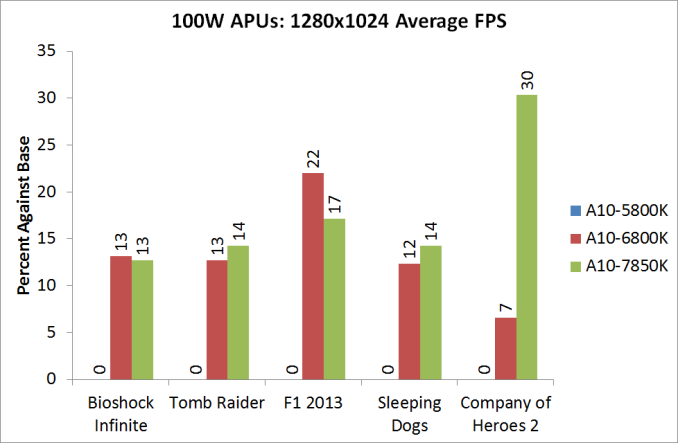
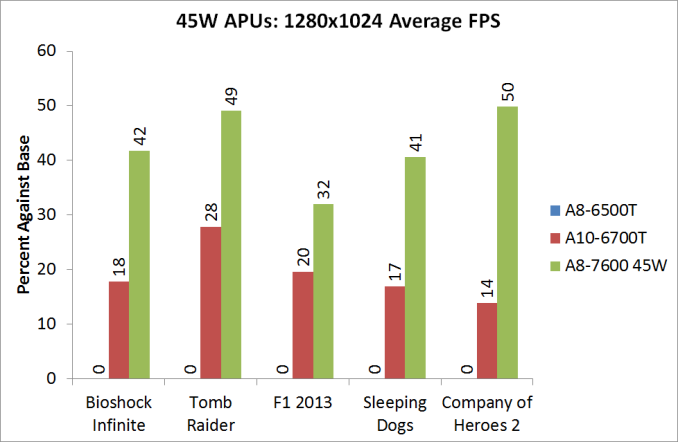
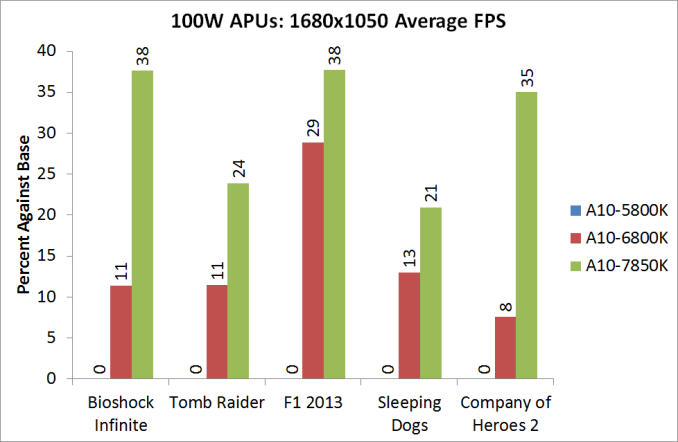
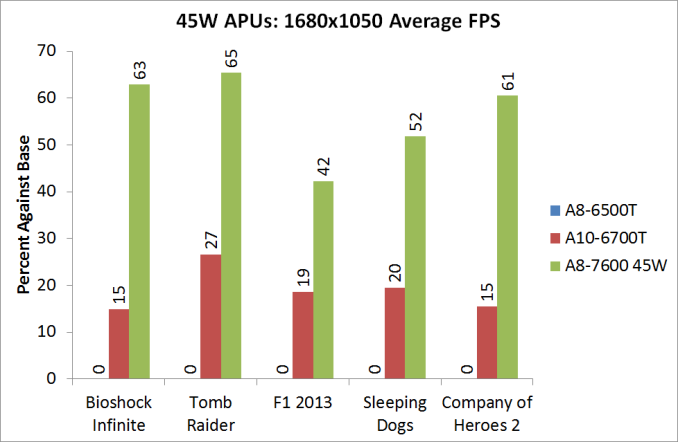
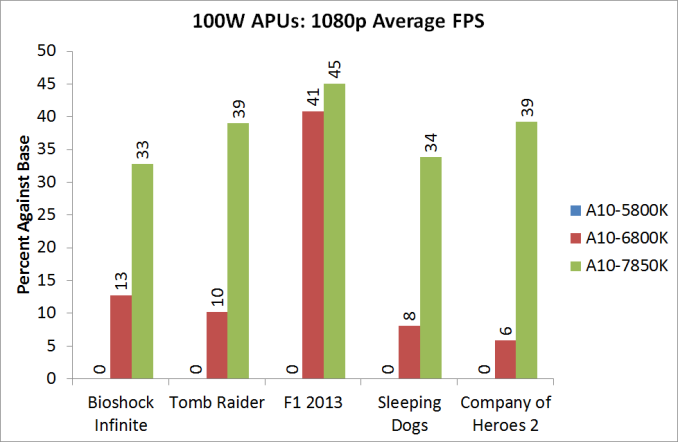

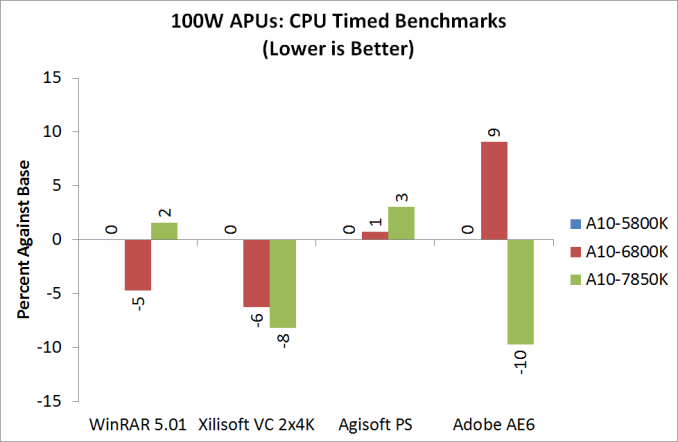
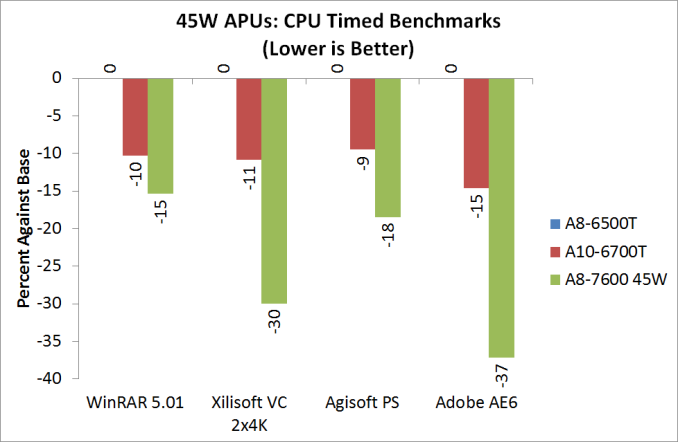

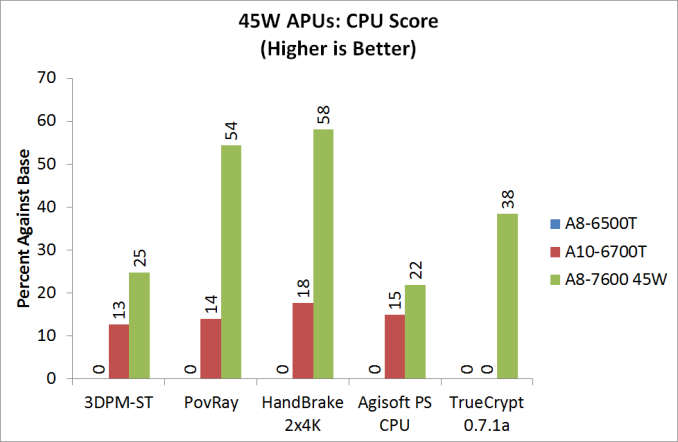
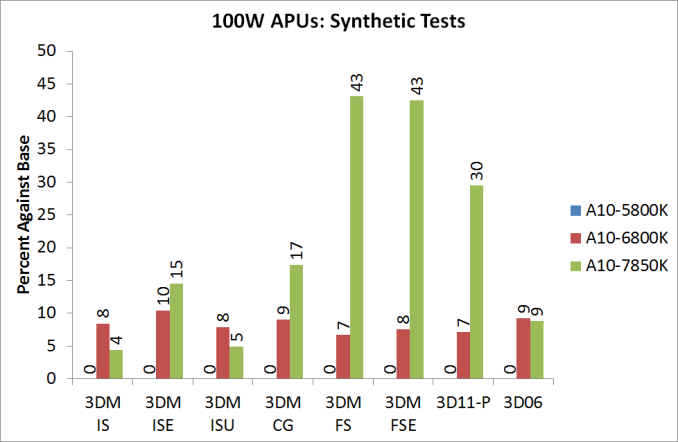
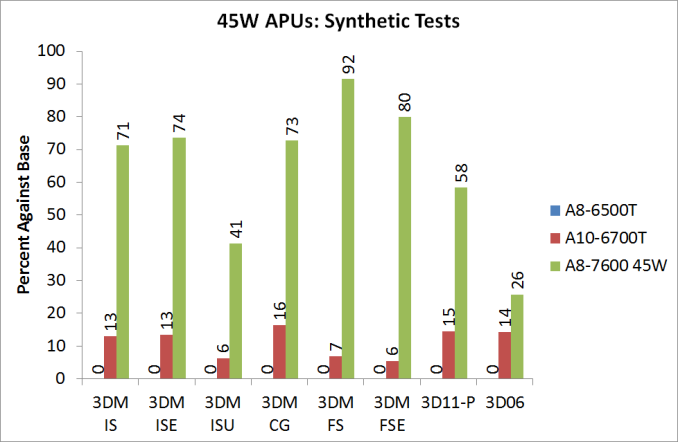
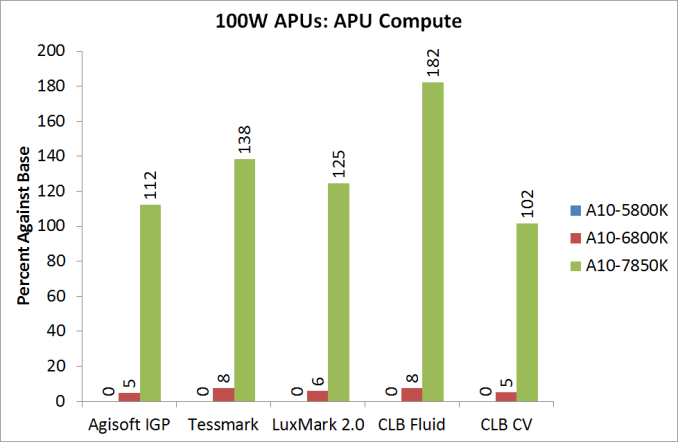

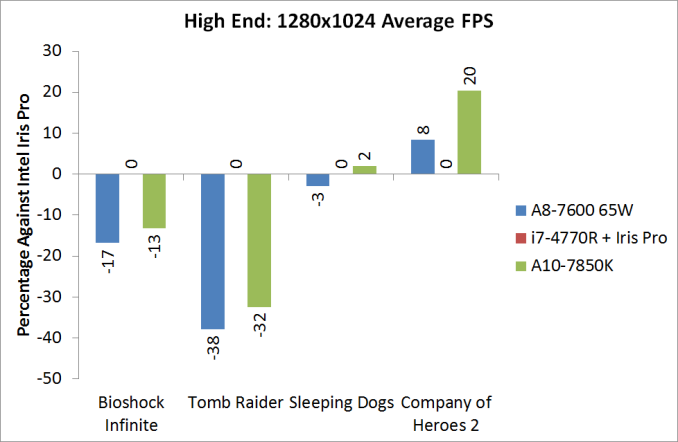
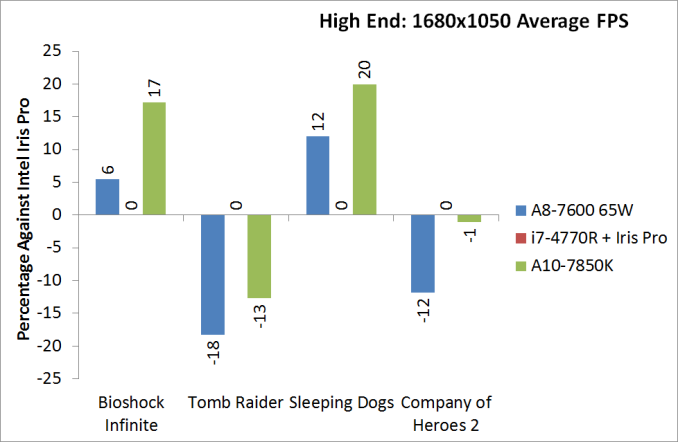
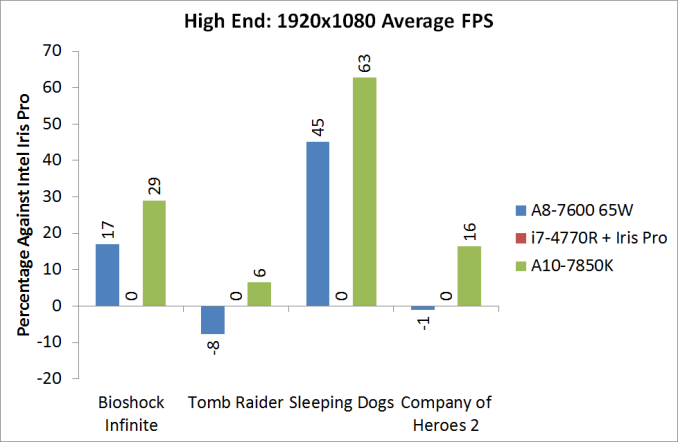








380 Comments
View All Comments
Fox5 - Tuesday, January 14, 2014 - link
Where are the Iris Pro results in CLBenchmark? Where are the CPU results of CLBenchmark; is the GPU faster than Haswell's AVX2? Where's the rest of the compute benchmarks, the area that Kaveri is supposed to shine in?JDG1980 - Tuesday, January 14, 2014 - link
Incidentally, will HTPC be covered in a different review? MadVR could be a good use case for Kaveri, as it requires quite a bit of shader power but isn't that memory bandwidth intensive.beomagi - Tuesday, January 14, 2014 - link
Per charts, Why are 100W APUs slower in 1280x1024 than at higher resolutions??beomagi - Tuesday, January 14, 2014 - link
Also, 45W APUs are faster? Are the benchmarks different? The charts only mention resolution.beomagi - Tuesday, January 14, 2014 - link
Nevermind - I now see this is as a percent difference compared to the slower chip - the title said FPS and that threw me off.Ignore! :D
Dribble - Tuesday, January 14, 2014 - link
Call me cynical but it's just the same as the previous gen. If you want a small form factor extreme budget gaming box these will be pretty good. For the rest of the world if you don't care about games you'd do better going Intel, and if you do intel + a proper graphics card.As with previous gen it comes with a load of marketing slide advantages, which if previous gen are anything to go by will come to nothing - I don't see the current range of AMD machines blowing away intel machines with opencl/stream/fusion/whatever - and that was what was on the previous set of marketing slides.
I always thought their best bet was mobile - but these days that markets getting really tough now for AMD as Intel have just spent the last few years optimising power usage.
UtilityMax - Tuesday, January 14, 2014 - link
The biggest elephant in the room is that very few average people (those who don't visit this web site) care for playing games on laptops (or even desktops, considering the consoles). Once you ignore the gaming performance, the A10 APU effectively has the performance of Core i3, but at a high price. A Fry's or Best Buy "special" laptop with Core i3 can cost as low as $400 or less. But the A10 laptops cost around $500. Intel's pricing is pretty aggressive on the low end IMHO.jimjamjamie - Thursday, January 16, 2014 - link
Not just in laptops, the price/performance ratio of the dual-core Pentiums is extremely good - the Haswell-based Pentium G3220 (3GHz dual core, 3.5MB cache) is available in the UK for just over £40, which is excellent value.Nagorak - Wednesday, January 15, 2014 - link
Yes, the issue is that the hybridization of CPU/GPU really provides no advantages. For someone actually playing games the GPU is still too weak and they'd be better off with a discrete card. For someone not playing games the quality of the integrated GPU doesn't matter.Maybe I'm wrong and there are tons of people out there playing games at ~30 FPS with low settings. I just don't see why someone who wants to play games wouldn't try to cough up an extra $100 for a discrete GPU, and if you don't play games then even Intel's older HD GPUs are fine.
mikato - Wednesday, January 15, 2014 - link
*For someone actually playing [newer 3D intensive] games the GPU is still too weak and they'd be better off with a discrete card. Yep*For someone actually playing [older or lighter] games the GPU is good enough and you end up with a cheaper overall package without needing a discrete card.
*For someone not playing games, they will benefit big time from HSA eventually. Not there yet and depends on the software.
There are probably more people in the last two categories if you think about it. AMD isn't for us gamers right now unfortunately. And it's going to take a while for adoption for HSA to bring in the third category of people.